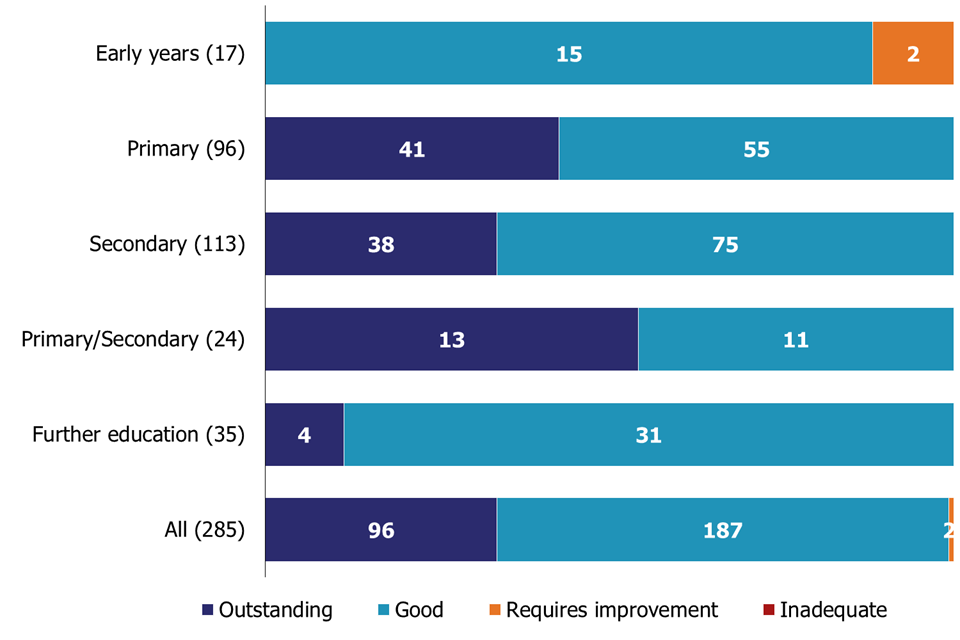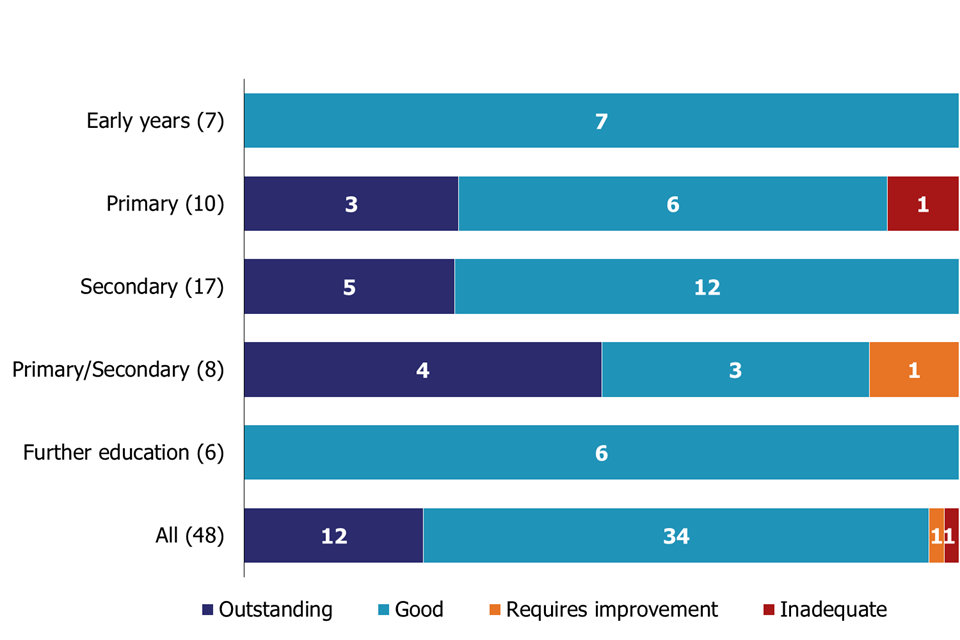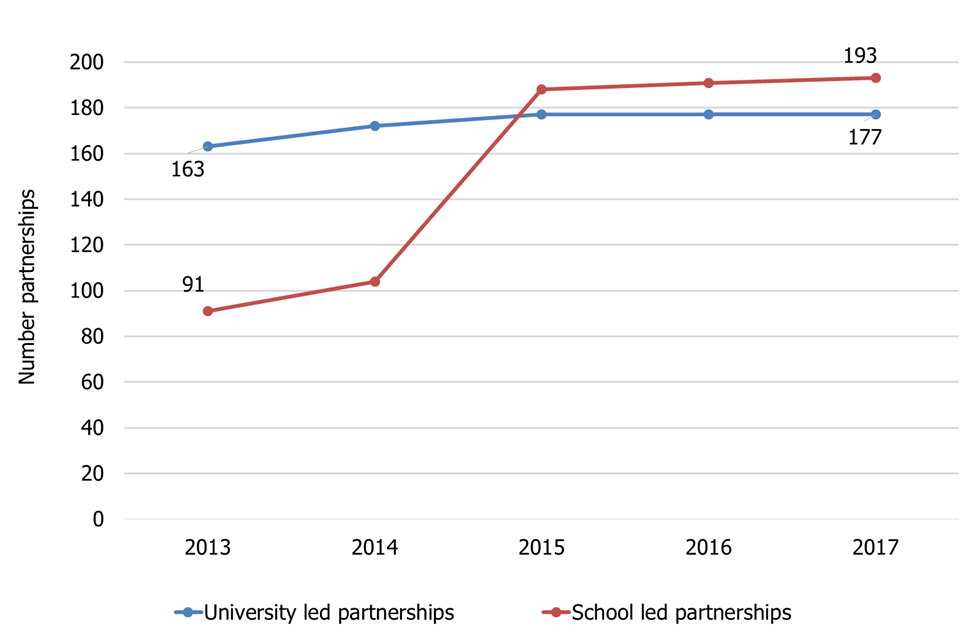Initial teacher education inspection statistics as at 30 June 2017
Updated 2 February 2018
This release contains:
-
data for inspections completed between 1 September 2016 and 31 August 2017
-
most recent inspection outcomes as at 30 June 2017
Ninety-nine per cent of all partnerships are good or outstanding.
This is the same proportion as the end of the previous academic year. The proportion of outstanding partnerships has fallen by one percentage point. This has been offset by a one percentage point rise in the proportion of good partnerships.
Most recent overall effectiveness as at 30 June 2017

Most recent overall effectiveness as at 30 June 2017
This is the first time that all further education partnerships have been good or outstanding.
This is because, of the 6 further education partnerships inspected this academic year, 5 retained their good grade and 1 partnership improved from requires improvement to good.
There are only 2 partnerships in England that require improvement. Both are early years partnerships.
This is the second year of inspections for early years partnerships. So far 17 have been inspected and all but 2 have been judged to be good at their most recent inspection. The 2 partnerships that require improvement have no trainees allocated for next year.
1. How Ofsted inspects initial teacher education
Initial teacher education (ITE) inspections take place over 2 stages:
-
Stage one occurs in the summer term and allows inspectors to observe trainees during training — no inspection judgements are formed during this stage.
-
Stage two takes place in the following autumn and focuses on observing newly qualified teachers or former trainees[footnote 1] in the classroom — outcomes of inspections are only finalised after the second stage.
This release covers the partnerships which had the second stage of their inspection in autumn 2016.
Each provider of initial teacher education can offer training for up to 4 different age ranges. These are called age phase partnerships and cover:
-
early years
-
primary
-
secondary
-
further education
Any age phase partnership found to be less than good will receive a single stage follow-up inspection within the same academic year. The outcomes for these inspections are also included in this release.
In most inspections a separate set of inspection judgements is awarded to each age phase partnership. Ofsted may produce a combined judgement for both primary and secondary phases if a provider only has a small number of trainees.
Different age phase partnerships can be inspected at different times, even those within the same provider.
Where ‘provision is repeatedly of requires improvement or lower quality’, the National College for Teaching and Leadership will often withdraw trainee allocations until the partnership has been judged to be good or outstanding. As a result, some providers close all or part of their provision when judged to be less than good. This is one reason why inspection outcomes are so high: weaker providers or partnerships often close, and closed providers are excluded from the statistics on the outcomes for all providers at their most recent inspection.
2. Outcomes of partnerships at their most recent inspection
As at 30 June 2017, there were 285 age phase partnerships with an inspection judgement. Ninety-six partnerships were judged to be outstanding (34%), 187 were judged to be good (66%) and 2 age phase partnerships were judged to require improvement (1%). There were no inadequate age phase partnerships.
Ninety-nine per cent of all partnerships are good or outstanding. This is the same proportion as the end of the previous academic year.
Although the overall proportion of good or outstanding partnerships has remained static, the proportion of outstanding partnerships has fallen by one percentage point since last year. This has been offset by a one percentage point rise in the proportion of good partnerships, from 65% last year to 66% this year.
Chart 1: Most recent overall effectiveness as at 30 June 2017

Most recent overall effectiveness as at 30 June 2017
Even though the overall picture of ITE inspection outcomes is very positive, there are some differences between the phases. More than half (13) of combined primary/secondary partnerships were judged outstanding and 43% of primary partnerships were outstanding. No early years partnerships were judged outstanding and only 4 out of 35 further education partnerships were judged outstanding.
This is the first time that all further education partnerships are good or outstanding (chart 1). This is because, of the 6 further education partnerships inspected this academic year, 5 retained their good grade and the University of Essex improved from requires improvement to good at its single stage inspection.
There are only 2 age phase partnerships which require improvement: early years training at the Manchester Metropolitan University and the University of Sunderland’s early years partnership. In both cases this is the second consecutive requires improvement judgement for this provision. Neither provider has been allocated any trainees for the early years age phase partnership for the 2017 to 2018 academic year.
3. Regional inspection outcomes
As we would expect from the national picture, inspection outcomes are high across the country. The vast majority of partnerships were judged to be good or outstanding at their most recent inspection in each of the 8 Ofsted regions.
Within this overall picture of strong performance there are some regional variations in the proportion of partnerships judged to be outstanding. The number of partnerships in each region is quite small, and the number of trainees in each partnership varies considerably, so care should be taken when interpreting these statistics.
Around half of partnerships in each of the South West and London regions were judged outstanding at their most recent inspection (chart 2). The East of England has the lowest proportion of outstanding partnerships - only 5 of the 31 partnerships are outstanding. The majority of partnerships in London and in the South West are university-led[footnote 2]: some 29 out of 46 partnerships in London and 18 out of 31 partnerships in South West are higher education institutions. In the East of England the majority of partnerships (19 out of 31) are based in schools[footnote 3].
Only 2 regions have partnerships that are less than good. One partnership in the North West, and one in the North East, Yorkshire and Humber, require improvement. These partnerships are both early years training, at Manchester Metropolitan University and at the University of Sunderland.
Chart 2: Most recent inspection outcomes by region

Most recent inspection outcomes by region
4. Inspections between 1 September 2016 and 31 August 2017
Ofsted conducted 29 inspections of 27 different providers between 1 September 2016 and 31 August 2017. Two providers were inspected twice. The 29 inspections resulted in 48 sets of inspection outcomes because most providers had more than one age phase partnership.
The inspections were a mix of two stage inspections and single stage follow-up inspections of partnerships which had previously been judged to require improvement.
At the end of the stage two inspections, 12 partnerships were outstanding, 31 were good, one required improvement and one was inadequate.
The 2 partnerships judged to be less than good at the end of their two stage inspections this year received a follow-up single stage inspection in the summer term. Both of these partnerships improved to good. Chart 3 combines the outcomes of each type of inspection this year, and includes an age phase partnership more than once if a partnership was inspected more than once during the year.
Chart 3: Overall effectiveness judgements between 1 September 2016 and 31 August 2017

Overall effectiveness judgements between 1 September 2016 and 31 August 2017
In addition, the University of Essex’s further education partnership also received a single stage follow-up inspection. This partnership was judged to require improvement in October 2014 and also required improvement at the follow-up inspection later in the same academic year. However the partnership was judged to be good at its second single stage inspection in November 2016. As outlined earlier, this is the first time, since the current inspection cycle started in 2012, that all further education partnerships are good or outstanding at their most recent inspection.
5. The changing landscape of ITE provision
Trainee teachers can take different pathways to gain qualified teacher status (QTS). These pathways, or routes, can be grouped into school-led or university-led routes:
-
on school-led routes, trainees are placed within a school from the first day of training, where they receive practical hands-on teacher training delivered by practising teachers
-
in university-led courses, the university or college delivers the pedagogy of teaching — this is supplemented by at least 2 placements in schools, where trainees put theory into practice
Five years ago, approximately three-fifths (61%) of all partnerships were based in universities. Today, less than half (48%) of partnerships are university based.
This change is mainly due to the growth of school-centred initial teacher training (SCITTs). The growth was at its largest between 2014 and 2015 where the number of school-led partnerships increased from 104 in 2014 to 188 in 2015. This rapid increase was driven by government policy towards school-led partnerships, leading to the creation of more SCITTs as well as the migration of employment based training partnerships into SCITTs. As Chart 4 shows, the number of school-led partnerships has increased year-on-year since 2013 and 52% of all partnerships are now based in schools. Despite the fact that the number of SCITTs has rapidly increased, the number of university-led partnerships has also increased slightly in the same period, from 163 to 177.
Generally, school-led providers are small and take fewer trainees than university-led providers. For example, 79% of university based providers offer at least two age phases and many (47%) offer at least three age phases. However, just over half (54%) of school-led providers specialise in a single age phase[footnote 4].
The average number of trainees in school settings in the academic year 2016 to 2017 was about 50; for universities it was about 530. This means that although fewer than half of partnerships are based in universities, just under two-thirds (65%) of trainees are still training in university based partnerships.
Chart 4: Number of partnerships over time by provider type

Number of partnerships over time by provider type
The quality of training is similarly high in both school-led partnerships and university-led partnerships. Ninety-nine per cent of university-led partnerships and 100% of school-led partnerships were judged to be good or outstanding at their most recent inspection.
Even though the proportion of good and outstanding partnerships is similar between the 2 provider types, within that there is a difference in the proportion of partnerships judged outstanding. The proportion of university-led partnerships judged outstanding is lower than that for school-led partnerships, with 27% and 45% respectively.
6. Revisions
There are no revisions to the previous release.
7. Further information
7.1 Contact for comments or feedback
If you have any comments or feedback on this publication, please contact Louise Butler on 03000 131 457 or Louise.Butler@ofsted.gov.uk
7.2 Acknowledgements
Thanks to the following for their contribution to this statistical release: James Jordan, Issa Mohamed, James Twist and John Willman.
-
Qualified teacher status is only awarded for primary and secondary routes. Individuals who have completed courses in further education or early years settings are called ‘former trainees’. ↩
-
University-led includes universities and further education providers ↩
-
School-led includes school centred initial teacher training, Teach First and one employment based partnership. ↩
-
Number of age phases for a provider are based on the number of age phase partnerships that had trainees in the academic year 2016 to 2017 . ↩

